Leisler's
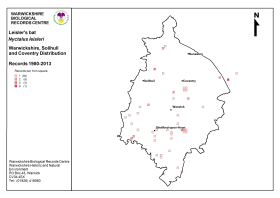
Distribution map for Leisler's bats in Warwickshire. (Click for a full sized image)
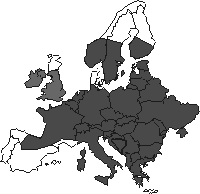 Leisler's
bat (Nyctalus leisleri) is similar to the Noctule
but smaller with longer fur, particularly around the shoulders and the upper
back, giving a lion's mane appearance. It was formerly known as the hairy-armed
bat. Adults have fur that appears golden-tipped or rufous-brown, the hairs
becoming distinctly darker at the base. As with the Noctule,
the tragus (lobe inside the ear) has a broadly rounded tip and is almost
mushroom-shaped.
Leisler's
bat (Nyctalus leisleri) is similar to the Noctule
but smaller with longer fur, particularly around the shoulders and the upper
back, giving a lion's mane appearance. It was formerly known as the hairy-armed
bat. Adults have fur that appears golden-tipped or rufous-brown, the hairs
becoming distinctly darker at the base. As with the Noctule,
the tragus (lobe inside the ear) has a broadly rounded tip and is almost
mushroom-shaped.
Leisler's bat is widespread but rare in Europe, including the British Isles,
Isle of Man, north to southern Scotland. A European stronghold is in Ireland,
where the species is the third most common bat and where the Noctule does not
occur. It is migratory in Europe with a record of 810 km. One British individual
was found 250 km (157 miles) from where it had been ringed 4 years previously.
It has also been found as a vagrant to the Shetland Isles.
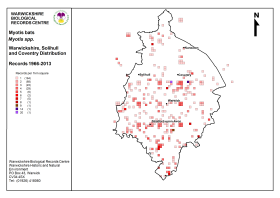
Distribution map for all species of Myotis bats in Warwickshire. (Click for a full sized image)
In view of its rarity in Britain all known roosts are important and special
care should be taken of roosts in buildings and of wooded areas where the
species is known to occur. Bat boxes have been successful in some areas. The
internationally important population in Ireland deserves special attention.
flight & ultrasound
Leisler's bats appear early in the evening soon after the Noctule
and have been observed emerging from houses at about sunset. They may stay away
from the roost until dawn. They usually fly high and fast in the open,
frequently at or below treetop level with shallow dives. Sometimes they fly
close to the ground along lanes and well-lit roads.

Leisler's bats' echolocation calls range from 15 to 45 kHz and peak at 25
kHz. The calls are occasionally audible to the human ear. On a heterodyne bat
detector a characteristic 'chip chop' with clicks at the top of the range is
heard but the sounds are les strident than that of the Noctule
bat. Leisler's has a loud call that is similar to the Noctule
("chip-chop") but with many more "chips" than
"chops". The Leisler's "chop" is normally heard best above
20 kHz (at around 25 kHz) as opposed to the Noctule's "chop" which is
generally heard best below 20 kHz.
Leisler's calls can be confused with those of the Serotine
or Noctule:
Serotine's do not make the "chip-chop" 2-part call of the Leisler's
but just a "chop" that is loudest at about 27 kHz. If a "chip-chop"
sound is heard with a heterodyne detector set to 25 kHz Serotines can
be discounted. Serotines are found more frequently at the edges of landscape
features such as treelines or hedgerows whereas Noctules and Leisler's
prefer a very open environment.
 Leisler's bat call on a Time Expansion bat detector.
Leisler's bat call on a Time Expansion bat detector.
breeding
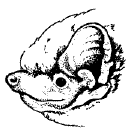 Mating
occurs from late summer until mid-autumn. Breeding males emerge from their
holes at dusk and slowly fly around calling loudly every second or so.
They keep within 300 m of their mating roost, returning to the roost after
several minutes, where they continue to call and await the arrival of
females. If no females arrive then the males fly around calling again.
These calls are audible to the human ear and are not the calls used in
echolocation. The males do not feed during the courtship period.
Mating
occurs from late summer until mid-autumn. Breeding males emerge from their
holes at dusk and slowly fly around calling loudly every second or so.
They keep within 300 m of their mating roost, returning to the roost after
several minutes, where they continue to call and await the arrival of
females. If no females arrive then the males fly around calling again.
These calls are audible to the human ear and are not the calls used in
echolocation. The males do not feed during the courtship period.
Male Leisler's bats can have a harem of up to 9 females; males give off
a strong, sweet odour during the autumn.
In the summer maternity colonies of females gather in tree holes and
sometimes in buildings, particularly in Ireland where colonies may reach
1,000. The young are born in mid-June. Usually a single young is born
but twins are recorded more frequently in eastern Europe.
summer roosts
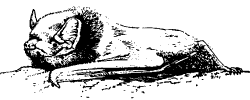 Leisler's
bat is naturally a forest bat roosting in tree holes for which bat boxes
have proved in some areas to be a useful substitute. They occasionally
share roosts with Noctules and Pipistrelles
and roost in old and new buildings. In houses they have been found around
the gable end in lofts, between tiles and underfelt, under ridge tiles,
above large soffit boards, behind hanging tiles, under loft floor insulation,
behind window shutters and in disused chimneys.
Leisler's
bat is naturally a forest bat roosting in tree holes for which bat boxes
have proved in some areas to be a useful substitute. They occasionally
share roosts with Noctules and Pipistrelles
and roost in old and new buildings. In houses they have been found around
the gable end in lofts, between tiles and underfelt, under ridge tiles,
above large soffit boards, behind hanging tiles, under loft floor insulation,
behind window shutters and in disused chimneys.
Leisler's bat is a mobile species and one roost is often occupied for
only a few days before the colony moves to another roost. The bats are
very vocal prior to emergence and are particularly noisy on hot summer
days, producing a loud metallic-sounding call.
winter roosts
Leisler's bats hibernate in tree holes, in the cracks and cavities of buildings
and occasionally in caves and tunnels. Elsewhere in Europe they sometimes
hibernate in large groups in rock crevices.
| Description |
|
| Head and Body Length |
50 - 70 mm |
| Forearm Length |
38 - 47 mm |
| Wingspan |
260 - 320 mm |
| Weight |
12 - 20 g |
| Colour |
Fur golden-tipped or rufous-brown, darker at base. |
|
|
| |
|
| Life Cycle |
|
| Mating Period |
End August - October |
| Maternity Colonies |
Established late spring.
Young: 1 born mid June. |
| Colony Size |
20 - 50 bats |
| Longevity |
Up to 16 years. |
| UK Status |
Vulnerable |
|
|
| |
|
| Habitat and Food |
|
| Summer Roosts |
Tree holes, bat boxes, buildings. |
| Winter Roosts |
Tree holes, buildings, occasionally caves and tunnels. |
| Feeding Habitat |
Open deciduous and coniferous woodland, parkland, suburban
areas and around street lamps. |
| Food |
Flies, moths, caddis flies, beetles.

|